Dog is an animal that has lived with people as a pet for more than 14,000 years, longer than any other animal. During that time, breeders have developed about 400 dog breeds to perform various tasks, provide companionship, and please the human eye.
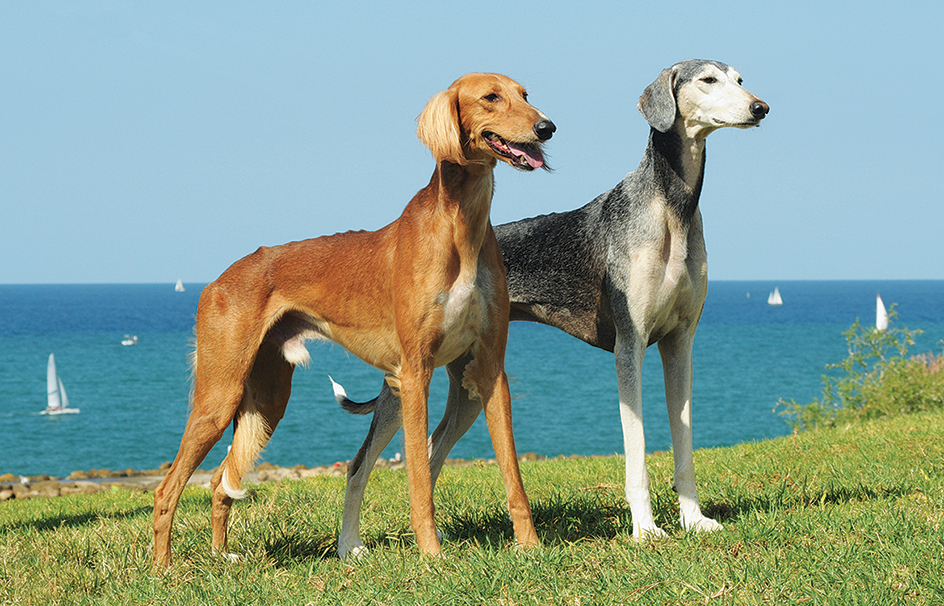
Most scientists believe that prehistoric human beings first valued dogs as watchdogs. Later, people realized that dogs could also be used for herding and hunting other animals. Over thousands of years, such breeds as collies, komondors, and pulis were developed to herd sheep, goats, and cattle. Hounds, pointers, retrievers, setters, spaniels, and terriers were bred for various kinds of hunting.
The intelligence, loyalty, and tracking ability that make dogs useful to herders and hunters serve people in other roles as well. For example, the police use dogs to track criminals and to sniff out illegal drugs and hidden explosives.
Dogs of all breeds provide company for human beings, and many breeds were developed for this purpose. These breeds include most of the small breeds called toy dogs, such as Japanese chins and Pomeranians. The companionship of a dog can contribute to a person’s general well-being. Scientific studies have shown that petting a dog slows the heart rate and lowers the blood pressure of the person who is doing the petting. 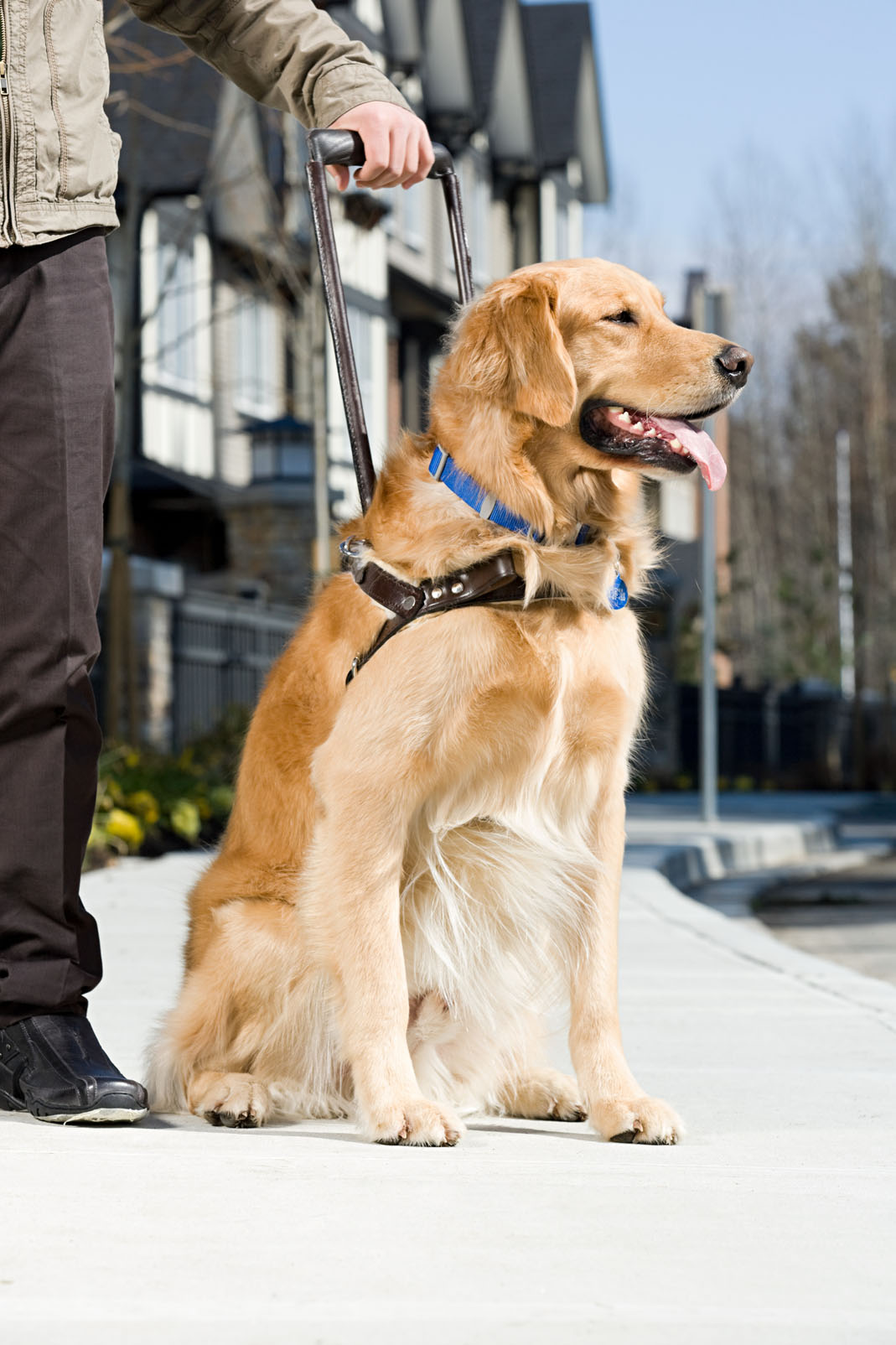
Dogs assist disabled people in many ways. For example, they guide the blind and serve as “ears” for the deaf. In addition, dogs lift the spirits of patients in hospitals and nursing homes.
Dogs have also entertained people for centuries. In earlier times, audiences enjoyed betting on fights between dogs and between dogs and other animals, such as bears, bulls, and lions. Many countries now ban such fights. Today, such contests as dog racing, field trials, and obedience trials draw large crowds. Dogs also perform in circuses, on stage, in motion pictures, and on television.
Some dog breeds have an unusual appearance. For example, the Mexican hairless has no fur on its body except for a few tufts on the top of the head. The loose skin of the Chinese shar-pei folds into wrinkles. These wrinkles are so deep that they may cover the animal’s eyes. The chow chow has a blue-black tongue. The basenji is the only dog that cannot bark, though it can make a singing sound.
The body of a dog
Dogs vary greatly in size. The smallest breed of dog is the chihuahua. Most chihuahuas stand about 5 inches (13 centimeters) tall at the shoulder. Most chihuahuas weigh no more than 6 pounds (2.7 kilograms). The heaviest dogs are mastiffs and St. Bernards. Large male mastiffs and St. Bernards may weigh 200 pounds (90 kilograms). The tallest dogs are the Irish wolfhound and the Great Dane, both of which can reach heights of 39 inches (99 centimeters) tall at the shoulder.
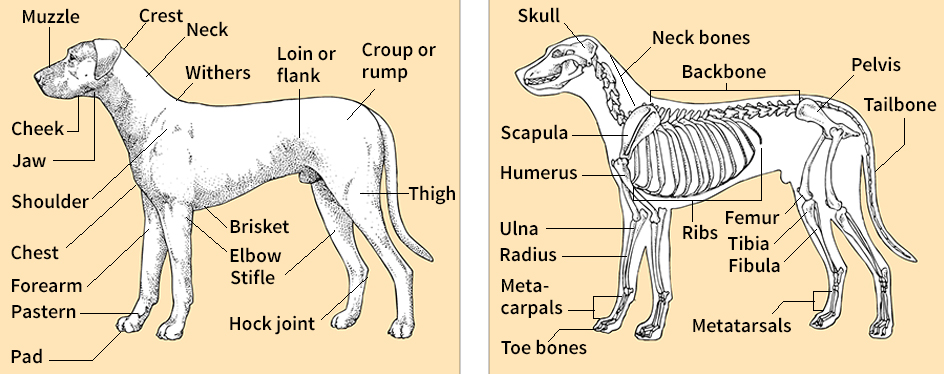
The shape and other characteristics of a dog’s body also vary widely from breed to breed. Dog breeds look so different from one another that it may be hard to believe that they are closely related. Nevertheless, dogs all have the same basic physical features. Except for limitations in size, all breeds can mate with one another and produce offspring.
Body structure
is primarily determined by the dog’s skeleton, which has an average of 320 bones. The exact number of bones varies, depending on the length of the dog’s tail. A male dog has one more bone than a female of the same breed because he has a bone called the os penis in his penis.
Some breeds, such as the Boston terrier and the bulldog, are born with short tails. Other breeds, including poodles, cocker spaniels, schnauzers, and boxers, are born with long tails, but a veterinarian may dock (cut off) the tail a few days after birth. This surgery does not benefit the dog and is done only because some people prefer the appearance of a docked tail.
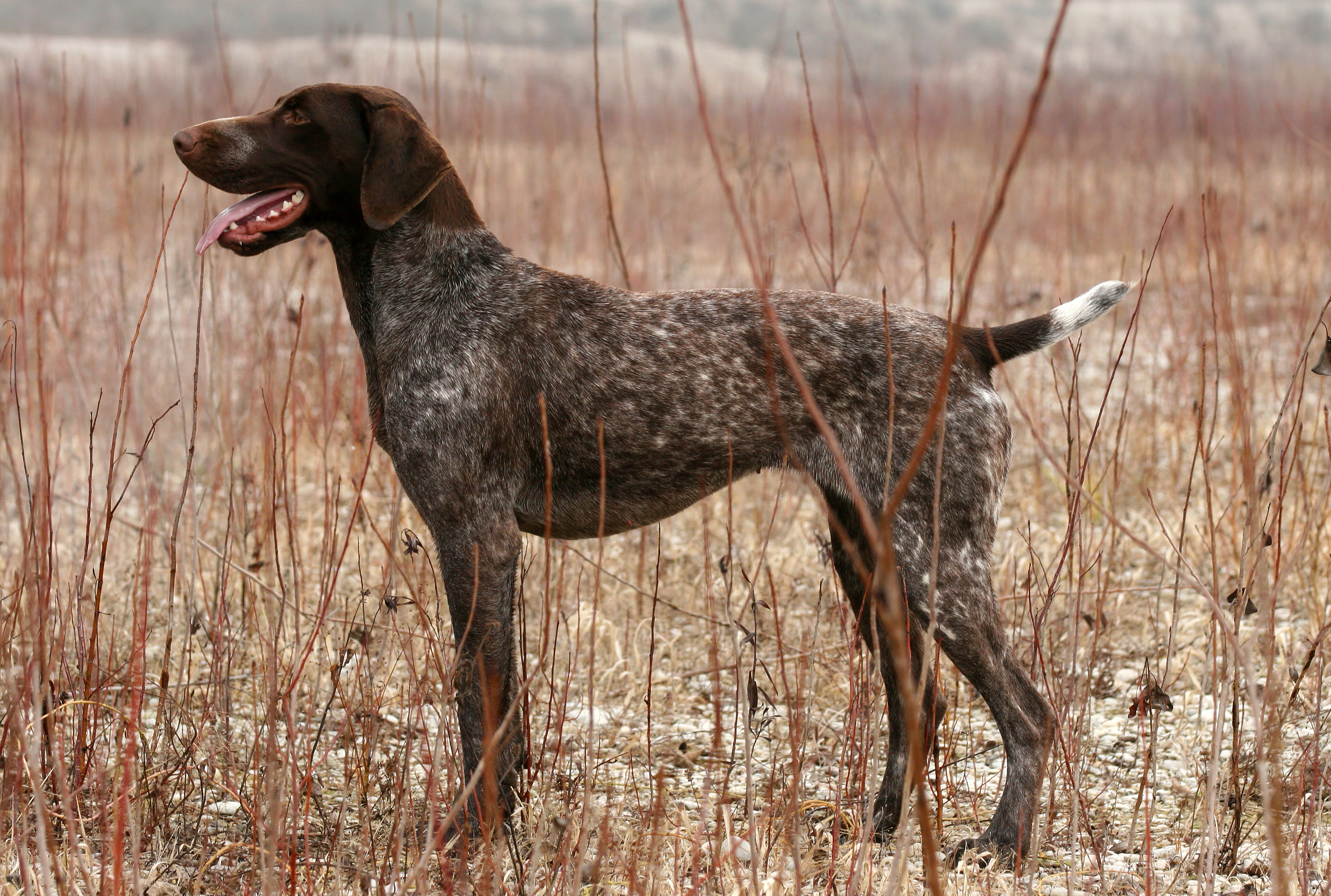
Most dogs have long legs. But some breeds, such as dachshunds, carry a gene for dwarfism that makes the leg bones extremely short and thick.
The shape of the skull determines whether a dog has a long, slender face like that of a collie or a short, broad face like that of the bulldog, pug, and Pekingese. Long-faced dogs have eyes that are nearer the sides of their heads, giving them a wide field of vision. Dogs with broad skulls have eyes that look forward like those of human beings, giving the dog better ability to judge distances.

Dogs have four toes on each hind foot and five toes on each forepaw. Some dogs are born with an extra toe called the dewclaw on each hind foot. Dewclaws serve no purpose and may be torn as a dog runs through brush. For these reasons, veterinarians often remove them along with the first toe on each forepaw when a puppy is a few days old. Dogs have curved toenails, sometimes called claws. Unlike cats, they cannot retract their claws.
Most puppies have 28 temporary teeth, which they begin to lose at about 12 weeks of age. Most adult dogs have 42 permanent teeth, which usually appear by 6 months of age. The dog uses its 12 small front teeth, called incisors, to pick up small objects and to groom itself. The 4 long, pointed canine or cuspid teeth are used to grab and hold large pieces of food. The 16 premolars are used to slice off smaller pieces of food. They also provide crushing and grinding action along with the 10 molars in the back of the mouth.
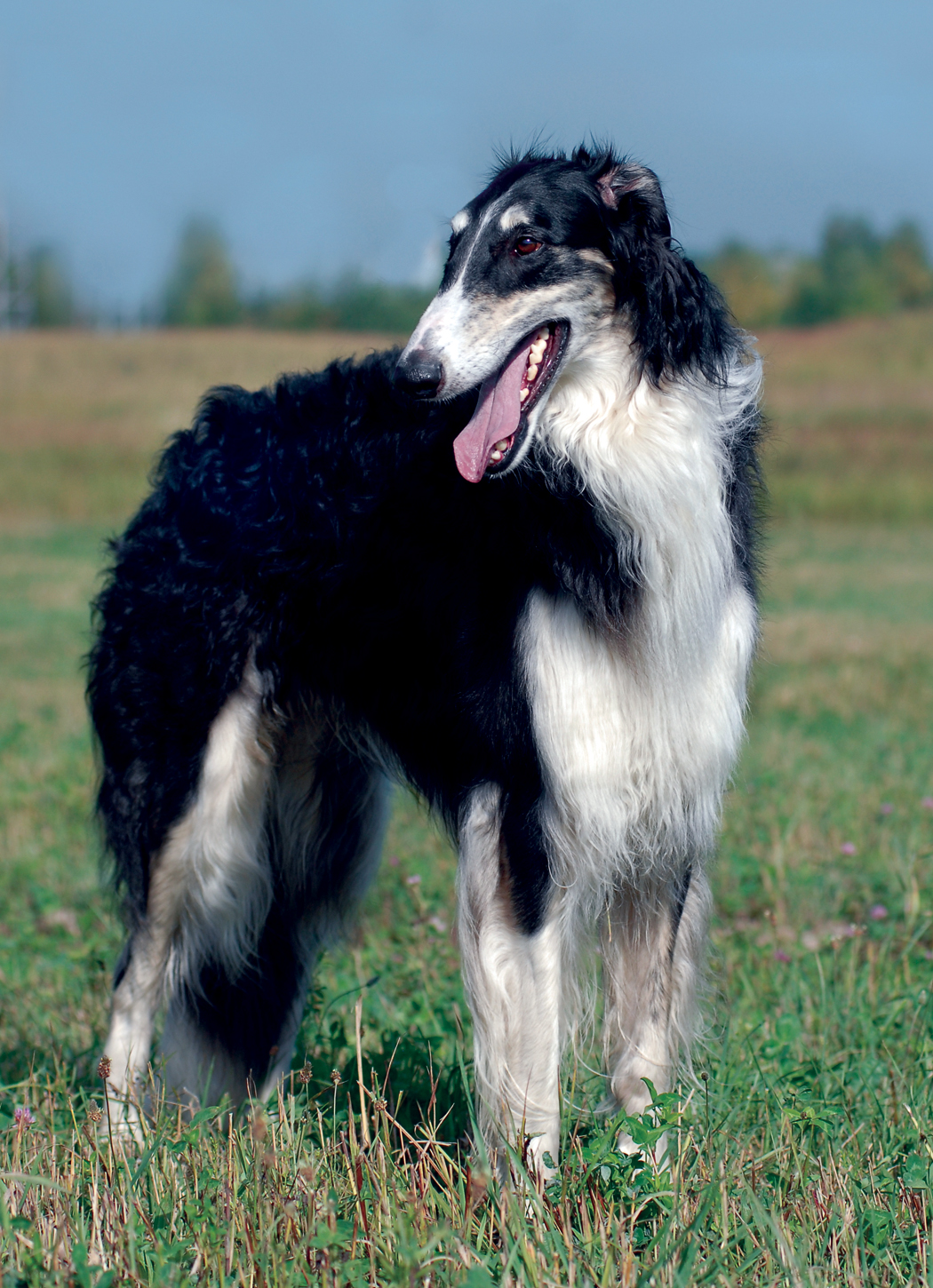
Many breeds of dogs have ears that are pointed and stand straight up. Such breeds include German shepherds, chihuahuas, and basenjis. Other breeds, such as the cocker spaniel, Labrador retriever, poodle, and beagle, have long, hanging ears that are called pendulous ears. Some people ask their veterinarian to crop (cut) the ears of certain long-eared breeds, including boxers and Doberman pinschers, to make them stand up. Cropping is done when the dog is a puppy. Because ear cropping is done only to change the dog’s appearance, many veterinarians refuse to perform the surgery. Kennel clubs in numerous countries ban the practice of cropping.
Coat.
Dogs have three basic types of hair in their coat. These types are (1) guard hairs, (2) fine hairs, and (3) tactile hairs.
Guard hairs are long, coarse hairs that make up the outer coat. They repel water and help protect the dog from rain and snow. Fine hairs make up the undercoat, which helps keep the animal warm. Although dogs normally shed some hairs continuously, most dogs shed their undercoat in the spring and regrow it in the fall. Tactile hairs, also called whiskers, are highly sensitive touch organs on the muzzle and cheeks and over the eyes. These tactile hairs may help dogs find their way in dim light.
The texture and length of the coat differ greatly among breeds. Boxers and miniature pinschers have a short, fine coat. The maltese, borzoi, and Afghan hound have long, silky fur. Poodles, Bedlington terriers, and Kerry blue terriers have coarse, curly coats. Some breeds, such as the Samoyed, provide fur from which yarn is made and woven into clothing.
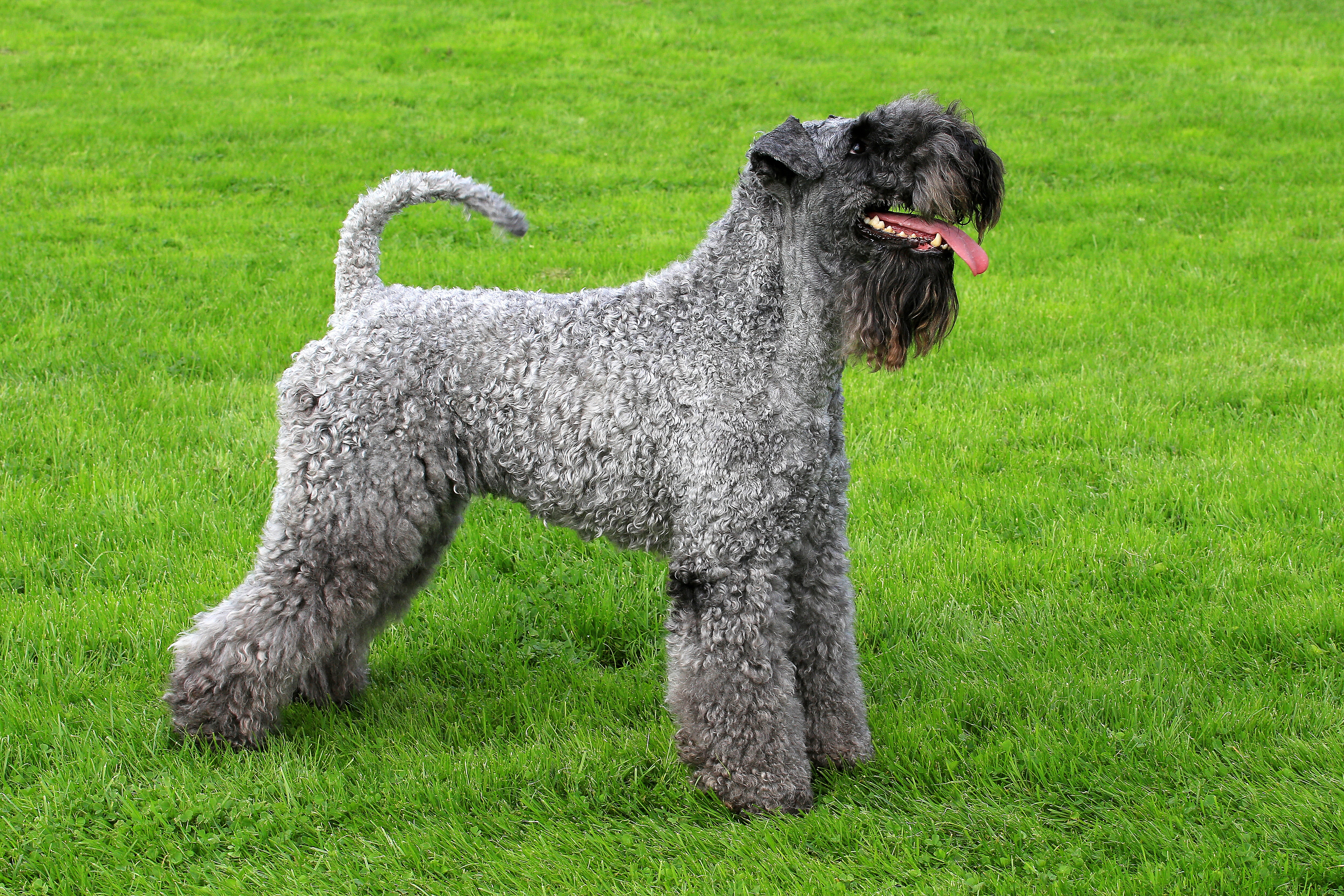
A dog’s coat may be made up of several colors, and members of the same breed may have differently colored coats. For example, a Labrador retriever may be light yellow, dark yellow, chocolate brown, solid black, or black with tan markings.
Senses.
A dog’s most highly developed senses are those of smell and hearing. Dogs can smell odors that the human nose is unable to detect. A dog can pick out an object that has been briefly held by a person from a group of identical objects that have not been touched. Some dogs, such as bloodhounds, are able to follow scent trails more than four days old under certain conditions.
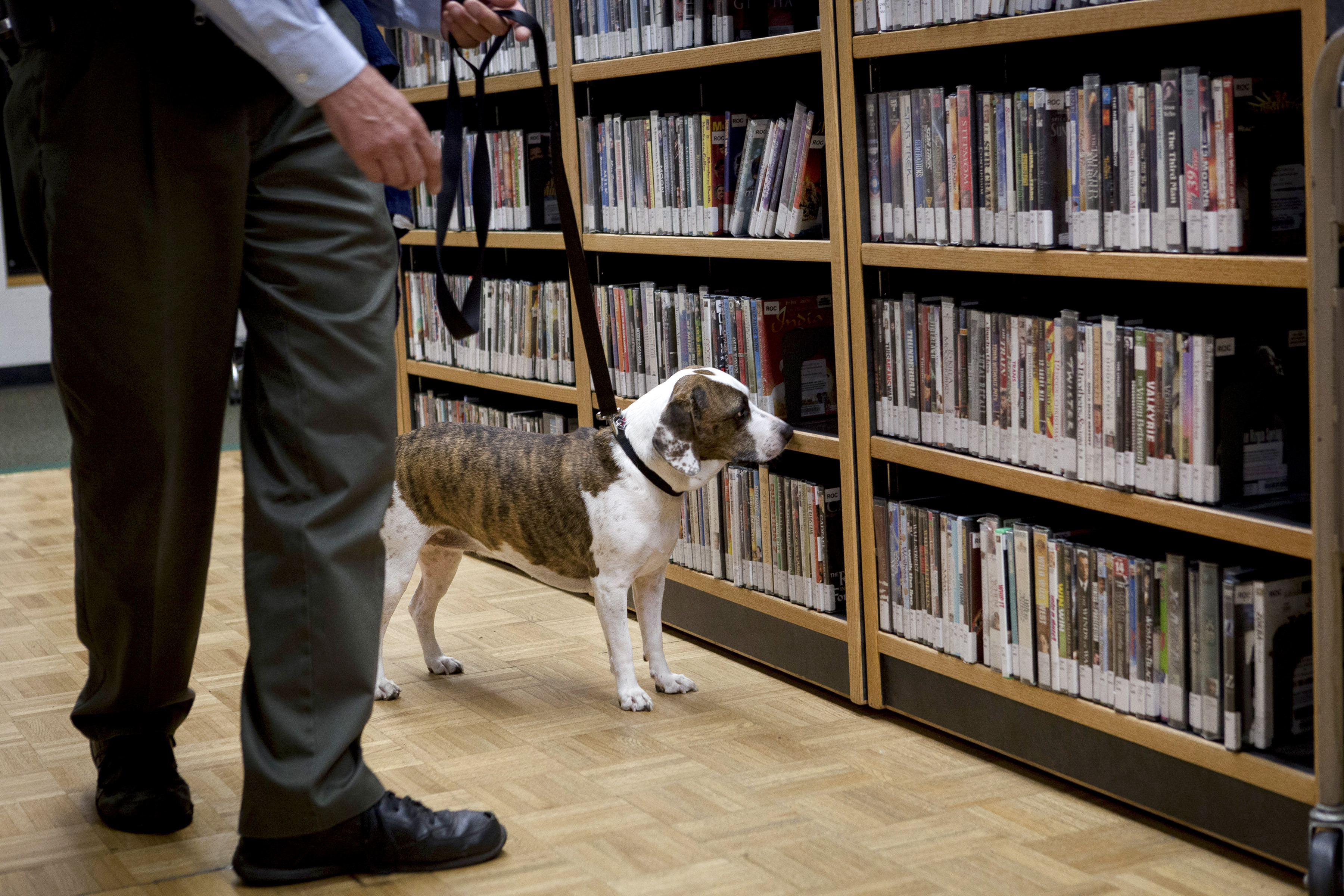
Dogs can also hear much better than people. They can detect high-pitched sounds that are above the limit of human hearing. Dogs also hear at great distances, and they can easily determine the direction of a faint sound.
Dogs cannot see forms and patterns as well as people can, but their sight is highly sensitive to motion. A dog’s color vision is mainly limited to shades of gray and perhaps blue. The colors green, red, yellow, and orange all look the same to dogs.
At the back of each eye, a dog has a mirrorlike structure called the tapetum lucidum. It reflects light and so helps the animal see in dim light. The tapetum lucidum makes dogs’ eyes appear to glow in the dark when a light strikes them.
Kinds of dogs
There are more than 400 kinds of purebred dogs. A purebred is a dog whose sire (father) and dam (mother) belong to the same breed and whose ancestors were purebred from the time the breed was recognized. In developing a breed, individual dogs that exhibit desired characteristics are mated. Mixed-breed dogs, also known as mutts or mongrels, have parents who belong to different breeds or who are of mixed breeding themselves. In the late 1900’s, breeders began mating different types of purebred dogs to produce specialized mixed breeds with desirable traits from both parent breeds. For example, poodles and Labrador retrievers were mated to produce labradoodles. Often called designer dogs or hybrid breeds, these dogs have become increasingly popular with pet owners.
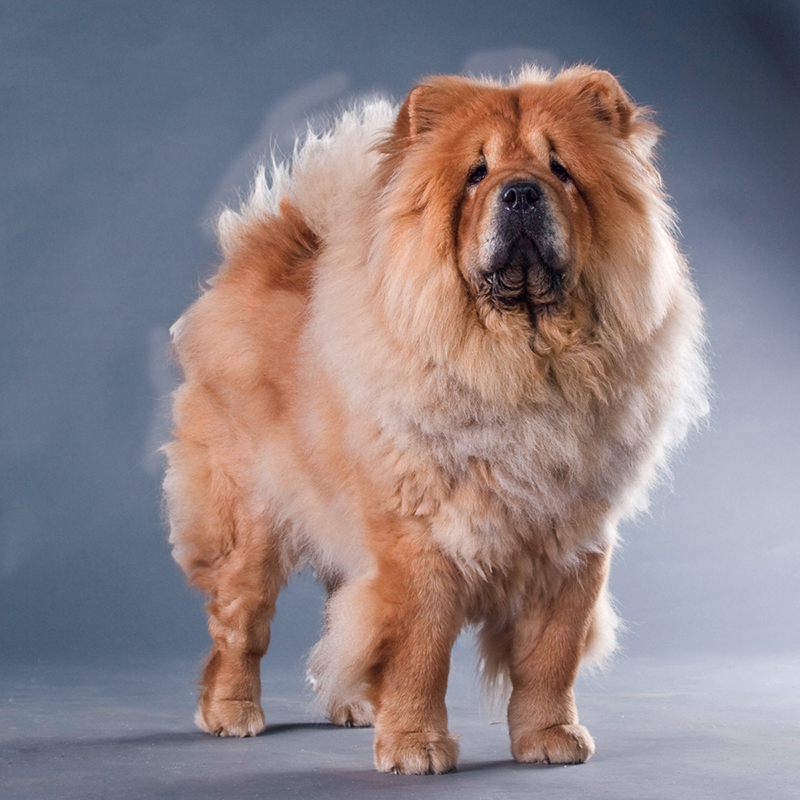
Various organizations throughout the world keep records of dog breeding. In the United States, the best-known dog registry is the American Kennel Club (AKC). The Canadian Kennel Club in Canada and the Kennel Club in the United Kingdom have similar functions.
The AKC classifies dog breeds into seven major groups for exhibition in dog shows. The seven groups are (1) sporting dogs, (2) hounds, (3) working dogs, (4) terriers, (5) toy dogs, (6) nonsporting dogs, and (7) herding dogs.
The AKC also has a miscellaneous category for dogs that are growing in popularity but that have not yet been accepted for registration.
Sporting dogs
were developed to assist hunters who use guns. Breeds in this group are also called gundogs. They include pointers, setters, retrievers, and spaniels. Pointers and setters point their body toward hidden game. Retrievers pick up birds that have been shot and bring them back to the hunter. Most spaniels, including cocker and springer spaniels, flush birds from the brush.
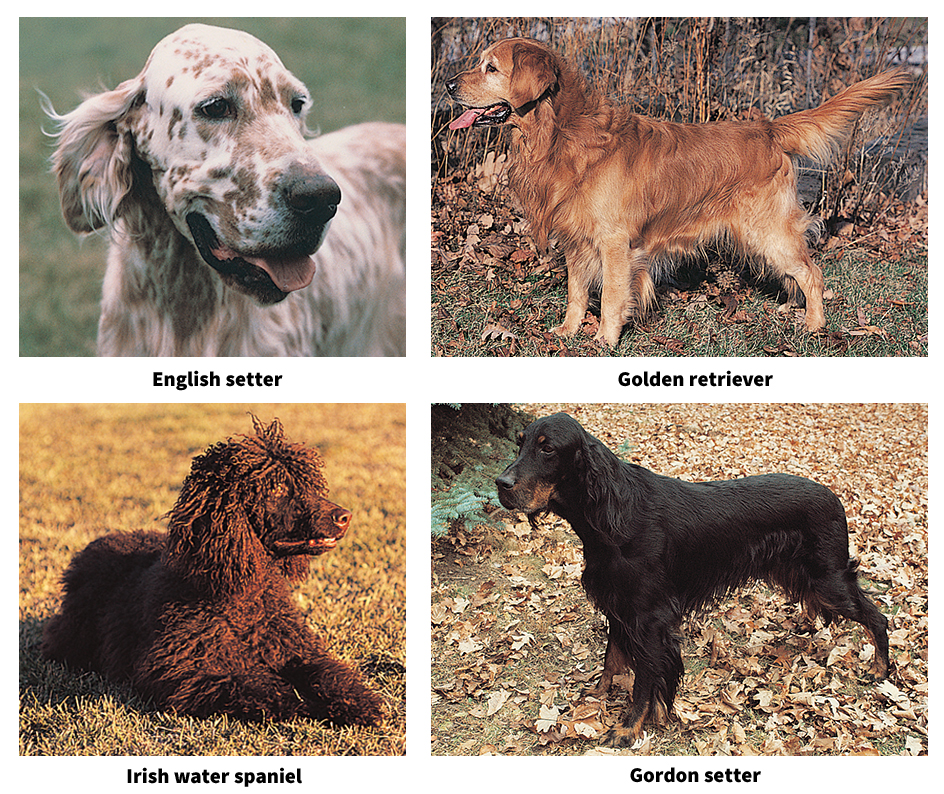
Hounds.
Members of this group are breeds that were developed to hunt. Some breeds in the group, including beagles, basset hounds, and bloodhounds, are called scent hounds because they hunt by scent. Others, such as greyhounds, salukis, and whippets, were bred to hunt game by sight and are known as gazehounds or sight hounds. Some hounds were developed to catch and kill the prey. Others corner the game and hold it at bay until the hunter arrives to kill it.
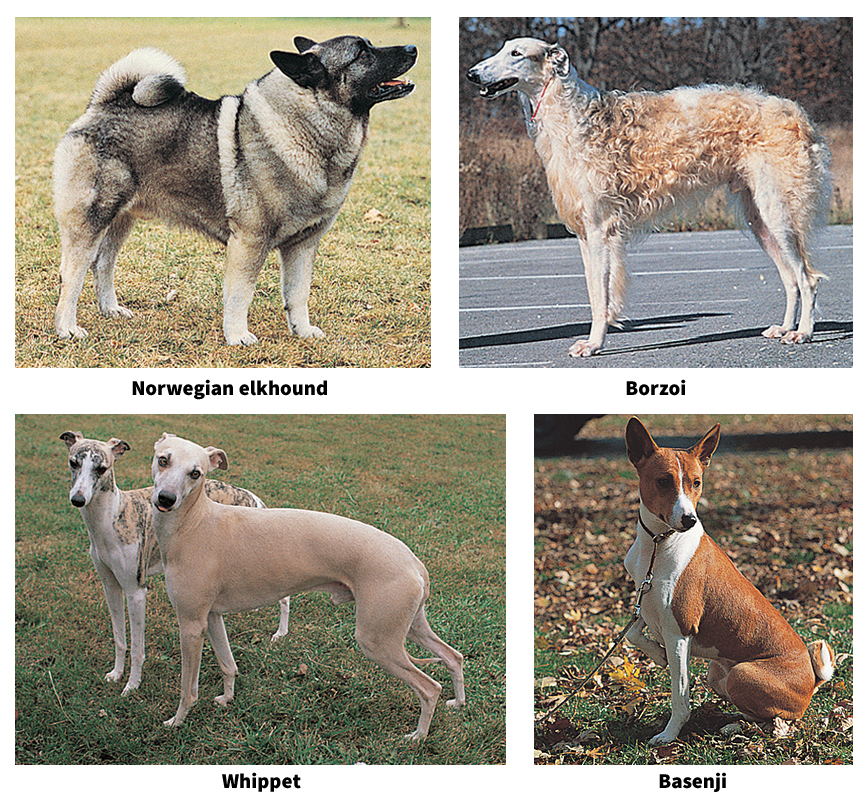
Working dogs.
Members of this group vary greatly in size and in the purposes for which they were developed. Working dogs include breeds developed for guarding and hauling. Alaskan malamutes, Samoyeds, and Siberian huskies pull sleds. St. Bernards and Newfoundland dogs were bred for rescue work.

Terriers.
Breeds included in this group were originally developed to dig into the earth to pursue prey. In the past, they specialized in hunting rodents and other small animals, such as badgers and rabbits. Some terriers were used for dogfighting before such contests were generally banned as cruel.
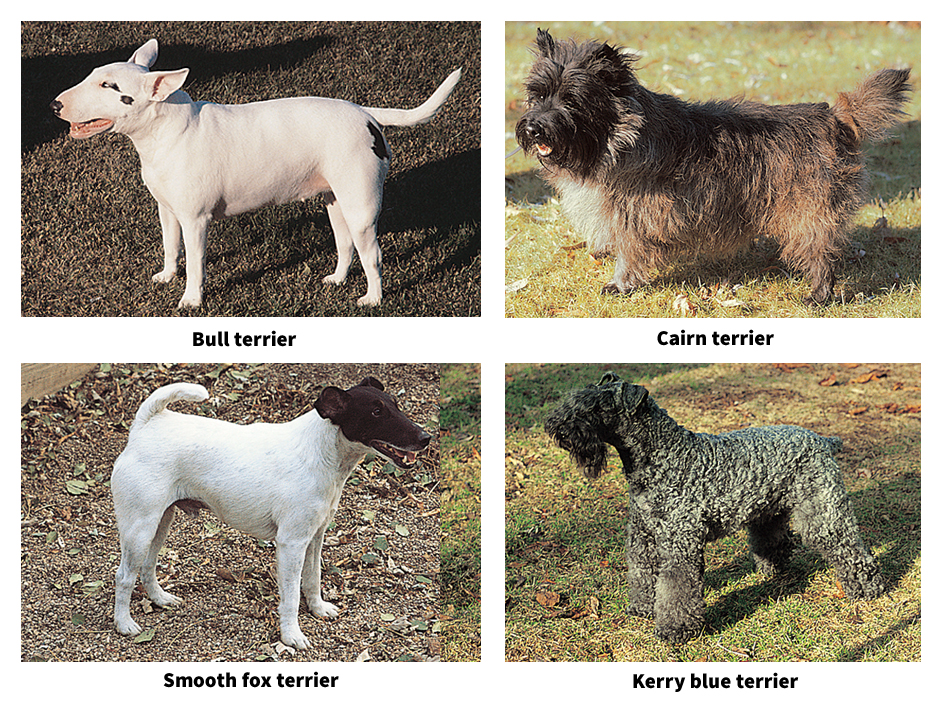
Toy dogs
consist of small breeds kept almost entirely as pets. Small varieties of poodles and Manchester terriers also compete in the toy group at dog shows. The largest toy dog is the pug, which may weigh up to 18 pounds (8 kilograms).
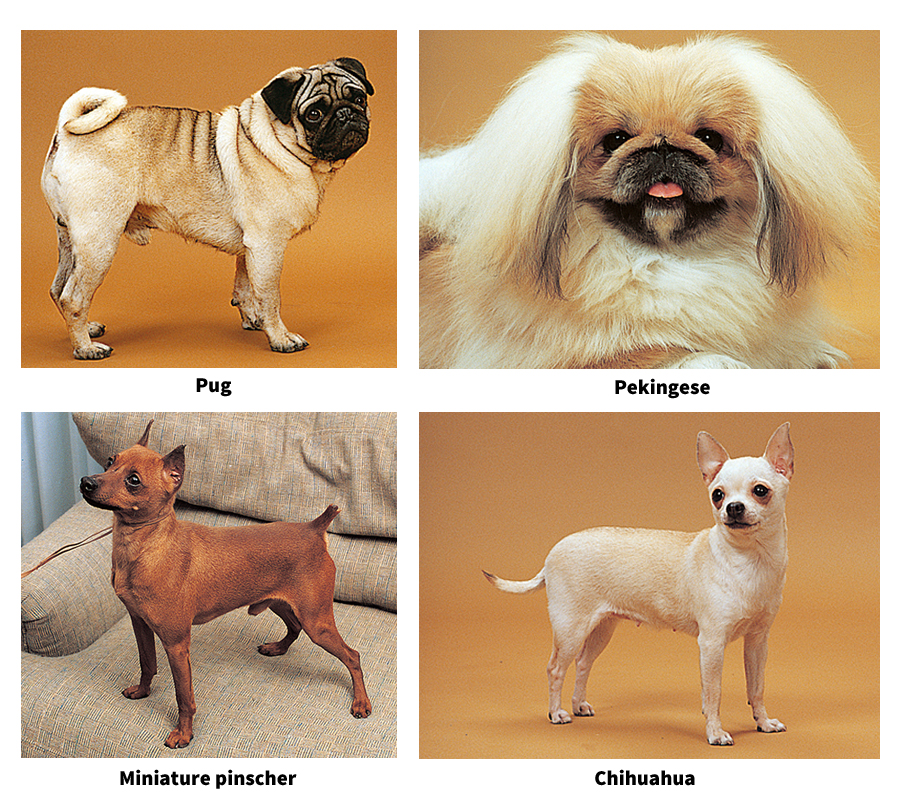
Nonsporting dogs.
Members of this group are large companion dogs that may have originally been developed for work or sport. Poodles, for example, once retrieved ducks for French hunters, and bulldogs were bred for a sport called bull-baiting.

Herding dogs.
Members of this group were classified in the working group until the AKC created a new group for herding breeds in 1983. All of these breeds were developed to keep sheep and cattle from straying and to protect livestock from predators. The herding group includes such popular pet breeds as the collie and the German shepherd.
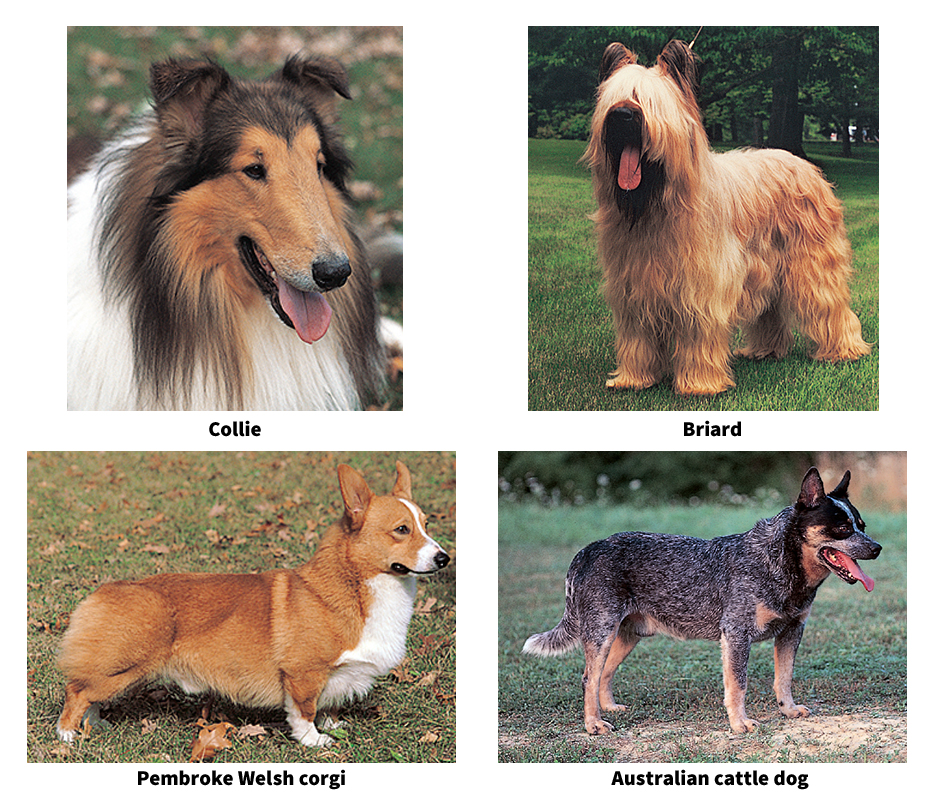
The life of a dog
Life history.
A female dog carries her young for about nine weeks before they are born. The number of puppies in a litter is determined mainly by the size of the mother. Small breeds usually have 1 to 4 puppies, medium breeds have 4 to 8, and large breeds have 6 to 10.
Puppies are helpless at birth. They cannot see until their eyelids open about 10 to 15 days after birth. Their ear canals also remain sealed for two to three weeks. A newborn pup cannot empty its bladder or bowels unless its mother licks the area under the base of its tail. Puppies normally begin walking just after 2 weeks and become steady on their feet when they are 3 weeks old. At that age, they also begin to bark and wag their tails.
Like other mammals, puppies live solely on their mother’s milk at first. Most pups begin to eat solid food at about 3 weeks of age and stop nursing by 6 weeks.
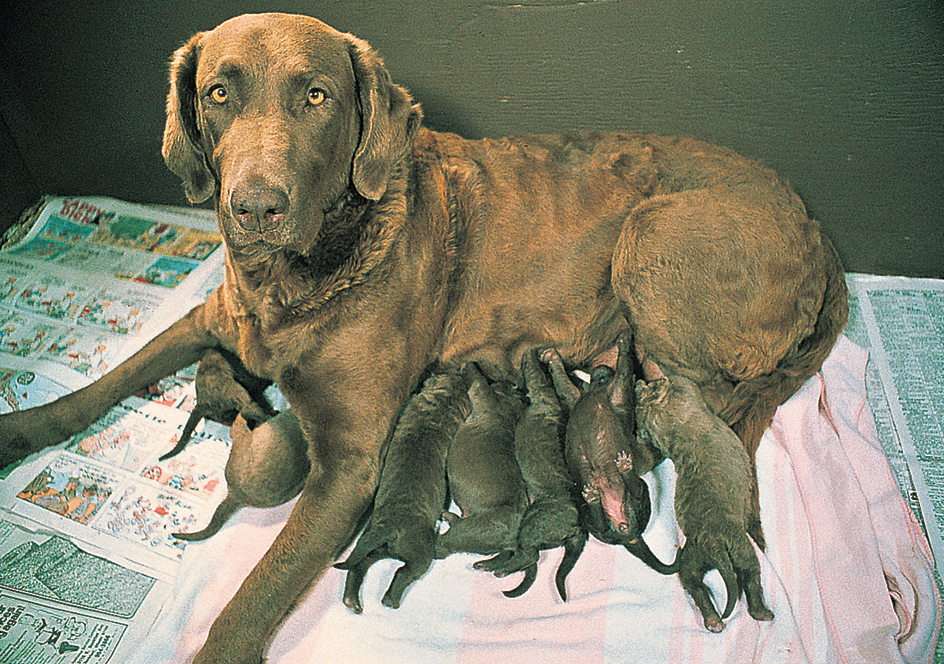
It is important for puppies to have contact with human beings if they are to become good pets. Newborn puppies should be handled gently for a few minutes each day. Between 4 and 10 weeks of age, pups need even more human contact or they will never relate well to human beings. The best time to adopt a new puppy is when it is 6 to 8 weeks old. Contact with other dogs is also important for puppies, or the dog may grow up to be too aggressive or too shy with other dogs.
Many puppies reach their adult height by 6 months of age but may continue to gain weight until 1 or 2 years old. Dogs often become sexually mature before they are fully grown. For small breeds such as the chihuahua, this may be as early as 5 months to 6 months old. For giant breeds, it may be as late as 11/2 years.
The length of a dog’s life depends on its genes, the biological structures that carry specific traits from one generation to the next, as well as on the care the dog receives. In general, small breeds live longer than large ones. It is not unusual for a toy poodle or pug to live 15 to 16 years. Giant breeds, such as the Great Dane and St. Bernard, are considered old at 8 or 9. Dogs that eat a healthful diet, get regular exercise, and receive good medical care usually live longest. The longest life span ever recorded for a dog was 29 years 5 months, for an Australian cattle dog. Because dogs mature at different rates, it is difficult to compare their ages directly to those of human beings.
Behavior.
Much of a dog’s behavior is instinctive that is, inherited rather than learned. For example, the digging and circling motions a dog performs before lying down, and the tendency to bury bones, are instinctive actions. Dog behavior resembles that of dogs’ closest wild relatives, wolves, who live and hunt in packs.
Loading the player...Dog behavior
Dogs use various vocal sounds, including barks, yelps, whines, howls, and growls, to communicate with other dogs and with people. These sounds mean different things in different situations. For example, whining may indicate pain when a dog is injured or merely anxiety when the dog is separated from its owner.
Dogs also communicate through body language (body and tail postures and facial expressions). For example, a dog uses a direct stare as a threat or challenge. But a dog will break eye contact as a sign of surrender to a more dominant (powerful) dog or person.
Still another means of communication involves scents. Both male and female dogs use urine to mark their territory. A pair of glands called the anal sacs appear near the anus, the external opening of the intestine at the dog’s rear end. These sacs produce a strong-smelling fluid that marks the dog’s bowel movement with an identifying odor. If a dog is frightened, the anal sacs may empty explosively, releasing a strong, unpleasant odor.
Dogs instinctively regard their owner’s house, yard, and the surrounding area as their own territory and will defend it against intruders. They do this by barking and sometimes by biting. Some dogs will also bite if they are cornered by a stranger who does not give them a means to escape.
Loading the player...Dog barking
People can avoid dog bites by never approaching strange dogs. If you must get close to an unfamiliar dog, it is important to understand the dog’s body language. The danger of a bite is greatest if the dog stands stiffly with its tail and ears erect and the fur on the back of its shoulders raised. It may bare its teeth and bark, growl, or both. Never stare directly into a strange dog’s eyes because it may consider your stare a threat and attack you. Instead, avoid eye contact, keep arms down, and slowly back away. Do not turn around to leave or run because this may trigger the dog’s instinct to chase you.
When introduced to a new dog, even one that appears friendly, be cautious. Kneel down to its level and let it approach you and sniff the back of your closed hand. Do not move suddenly, reach over the dog’s head, or stand over the dog. A dog that approaches with its body relaxed and its tail wagging is probably friendly even if it is barking. Many dogs bark as a greeting.
Choosing a dog
The decision to bring a dog into your home should involve serious consideration. Dogs are highly social animals. To be happy, they need the company of people, other animals, or both. If you do not have the time to give a dog the love and care it needs, then you should select a pet that needs less attention. Dogs often live for 10 to 15 years. If you cannot assume responsibility for care during the whole lifetime of a dog, it is better not to choose one for a pet.

After you are sure that you can give a dog a good home, you should decide what kind of dog would be best for you. Your dog’s personality should suit your own. If you live in a house or apartment without a large yard, consider a small dog that needs relatively little exercise. Look for a dog that will weigh less than 25 pounds (11.3 kilograms) when fully grown. A small dog can usually get all the exercise it needs if it has the run of an apartment and is taken for walks outside. Larger breeds usually require more space.
Small dogs eat less. Giant breeds often need as much food as an adult human being and are, therefore, more expensive to feed.
Dogs with short hair usually need little grooming. Long-haired dogs need more. Several breeds, such as poodles, require more extensive grooming, especially if the dog participates in dog shows. Therefore, it is important to investigate the amount of required grooming for any dog you consider and decide whether you can spend the time and money to provide it.
The chief advantage of selecting a purebred pup is that you know how the dog will look when it is grown. Purebred dogs, however, suffer from many inherited diseases. For this reason, you should buy a purebred dog only from an experienced breeder with a good reputation. You should also find out as much as you can about the dog’s parents and their ancestors. Visit dog shows and talk with the exhibitors to get information about the kind of dog you would like. A veterinarian may also recommend good breeders and help you choose a healthy dog.
The best thing about mixed-breed dogs is that each one is unique. Mutts come in every size, shape, and color. However, it may be difficult to predict the adult size and appearance of a mixed-breed puppy. Humane societies and animal shelters have good selections of mixed-breeds. Veterinarians, pet hot lines on the internet, and newspaper advertisements may also lead you to a fine pet.
When considering a puppy, visit its kennel or home and observe one or both of the parents if possible. Both the pup and its parents should be obviously healthy. Look for bright eyes, clean ears, sweet breath, and a shiny coat. The nose, eyes, and ears should be free of any discharge. The pup’s teeth should be straight. A normal puppy moves freely, without limping, and is active and playful. A dog that shrinks into a corner may be sick or overly shy.
Caring for a dog
Feeding.
Dogs require different kinds of foods during the various stages of their lives. At about 3 to 4 weeks of age, puppies need to supplement their mother’s milk with solid food. Provide a good-quality commercial product, either dry or canned, that is labeled as food for puppies. Soften dry food by moistening it with water or a puppy milk-replacement formula, or by mixing it with canned food, to make it easier for young pups to chew. You may also give a puppy cooked eggs and cottage cheese, but these foods should make up no more than 10 to 20 percent of the dry weight of the puppy’s diet.
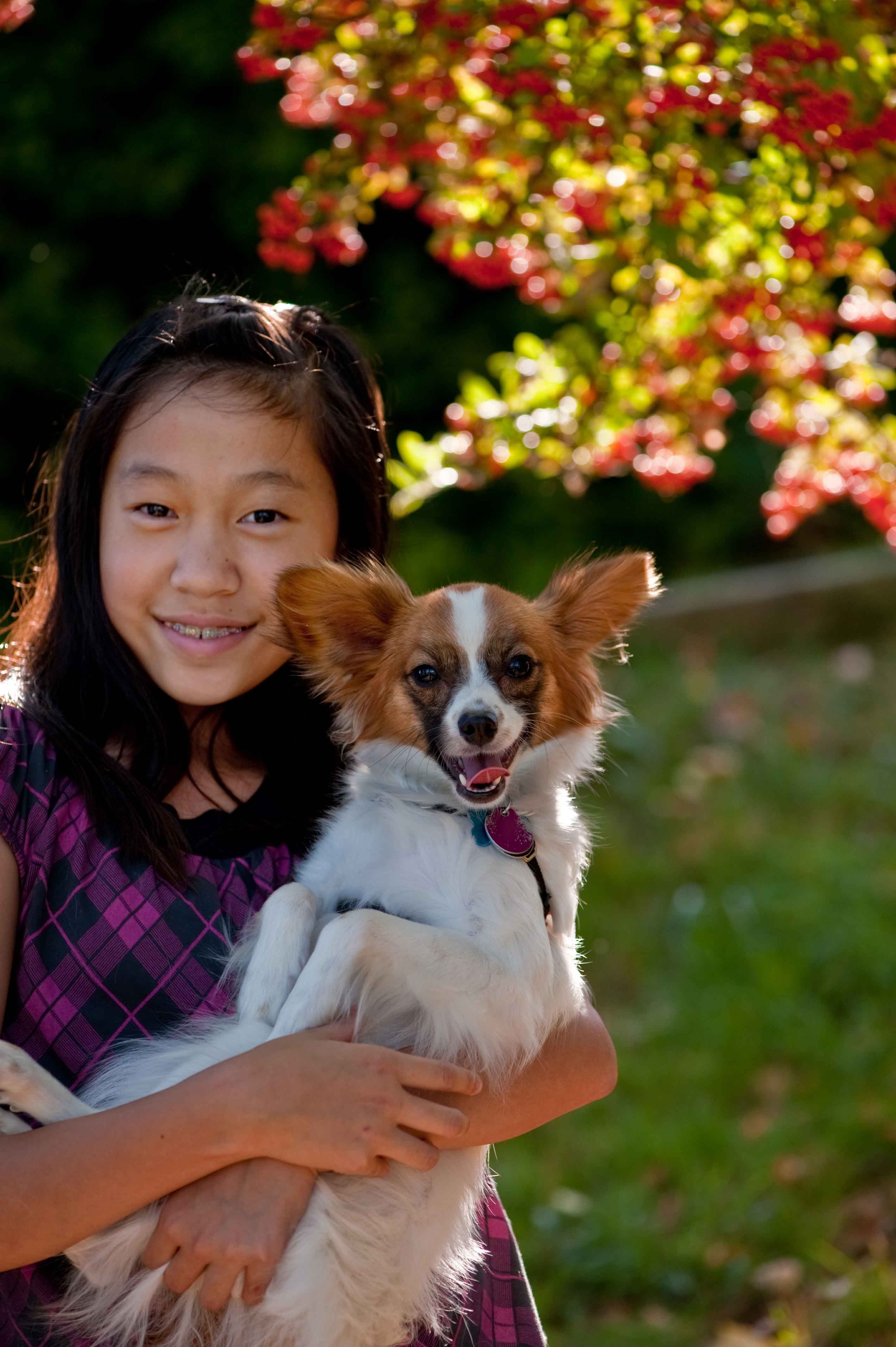
Both puppies and adult dogs can be fed by either the self-feeding or the portion-controlled method. In self-feeding, also called free feeding, the owner leaves food where the dog can get it and replaces the food as often as necessary to keep it fresh. A dog fed this way can eat at will.
In the portion-controlled method, also called hand-feeding, the dog receives enough food to leave it comfortably full at regular intervals. The owner allows about 20 minutes for a meal, then removes any remaining food until the next mealtime. A puppy should be fed four times a day until it is about 3 months old. The pup should then eat three times a day until it is 6 months old, then twice a day until it is fully grown. Adult dogs need only one meal a day, but many dogs prefer two smaller meals, one in the morning and one at night.
Provide fresh, clean water at all times in a bowl that your pet cannot tip over. Avoid feeding large amounts of meat and table scraps to dogs. Dogs fed these foods quickly develop a preference for them and may develop dietary imbalances and deficiencies. Vitamin and mineral supplements are unnecessary for healthy dogs who eat a complete, balanced diet.
Bone chewing is natural for dogs, but it can cause broken teeth, and splinters of bone may cause digestive upsets or internal injuries. For these reasons, many veterinarians recommend offering rawhide strips or special chew toys instead of bones. Old dogs and dogs with certain medical conditions such as heart or kidney disease may require special diets. Your veterinarian will advise you when special food is needed.
Sleeping quarters.
A dog bed may be as simple as a cardboard box lined with clean shredded paper or washable towels or blankets. All bedding should be replaced or washed frequently to avoid problems with fleas. Many veterinarians and dog breeders recommend a shipping crate or kennel for the dog’s bed. Dogs who sleep in such an enclosure adjust well if they must be confined for shipping, boarding, or hospitalization.
Dogs kept outdoors need a shelter that is waterproof and insulated from heat and cold. A garage, barn, or shed may serve, or you may buy or build a special doghouse. In any case, the door should keep out wind, rain, and snow, and the doghouse should be raised off the ground to protect the floor from cold and moisture. The house should be shaded from the sun in hot weather. In cold weather, even a well-insulated shelter may need a heat lamp or other source of warmth.
Grooming
prevents skin problems by keeping a dog’s coat clean and free from fleas and ticks. The kind and amount of grooming needed is determined by the dog’s fur type and length and by the animal’s life style. In general, dogs with longer fur need more frequent combing and brushing than those with short coats. Pets who spend a lot of time outdoors usually need more frequent grooming than those who live mostly indoors. Dogs also need regular ear inspection and cleaning, toenail trimming, and tooth inspection and cleaning.
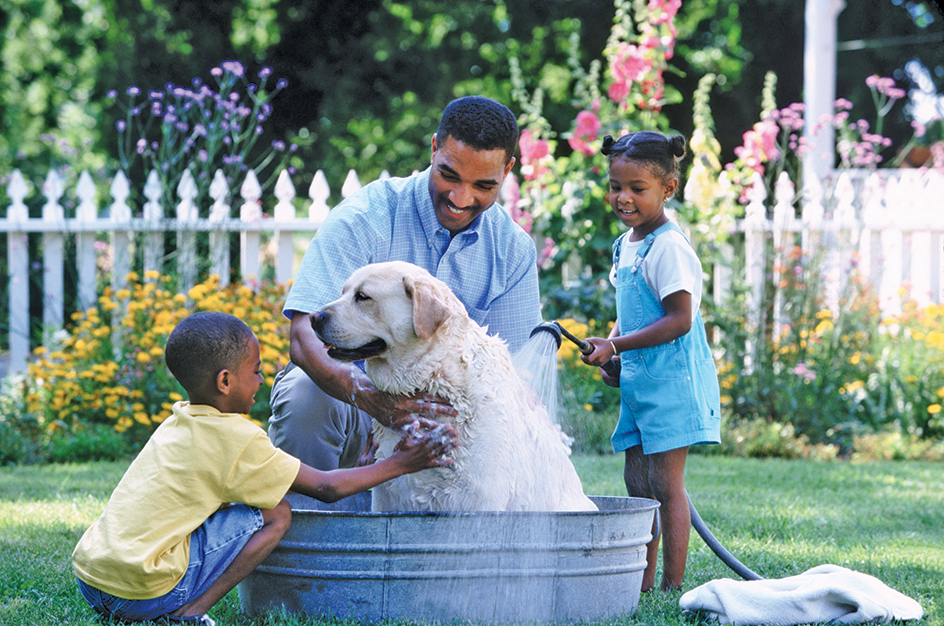
A mistaken idea held by many pet owners and some veterinarians is that a dog should be bathed as seldom as possible. In fact, you may wash your dog as often as necessary—in many cases, once a week. You must, however, use a special shampoo that does not strip the oils from the dog’s coat.
When you give your dog a bath, carefully pour warm water over your pet. Apply a gentle shampoo and lather well. You may choose to shampoo the dog’s head first, followed by the body, legs, and feet, or wait and shampoo the head last. Be careful not to get any shampoo in your dog’s eyes. Rinse thoroughly because any soap that remains on the skin may cause itching. After the bath, apply a flea- or tick-control treatment as recommended by your veterinarian.
Exercise and play.
Like human beings, dogs need exercise to remain physically fit and mentally healthy. The easiest way to exercise a dog is to release it in an enclosed space with another friendly dog. Dogs left alone may not remain active long enough to stay in shape. A dog will also benefit from daily brisk walks or jogs with its owner. Be sure to confine your dog to a leash if you walk or jog where there is traffic or if your city has a leash requirement.
Playing with your dog is another good way to keep it physically fit. A game of fetch is a favorite of many dogs. You can get ideas for other kinds of play by adapting the games dogs play with one another, such as chase, tag, and wrestling.
A dog invites another dog to play by assuming a posture called the play bow. The dog stands with its hind legs straight while bending down with its front legs and wagging its tail. Sometimes barking accompanies the invitation. The dog may alternate bowing with short jumps forward and hops backward. You can imitate the play bow by getting down on your hands and knees and stretching your arms forward on the ground.
Medical care.
Common signs of illness in dogs include a change in behavior, a change in appetite, and fever. Most animals become less active when they are sick or injured. Dogs may refuse to eat when they are ill, or they may just eat less. Some illnesses actually cause a dog to eat or drink more. Any change of appetite that lasts for more than a few days calls for a veterinary examination. If there are other signs of illness, such as vomiting, diarrhea, sneezing, or coughing, take your pet to a veterinarian as soon as possible. A dog that repeatedly scratches its ears or shakes its head may have an ear infection, especially if there is a foul-smelling discharge from the ears. If your dog has these symptoms, a veterinarian should check its ears.
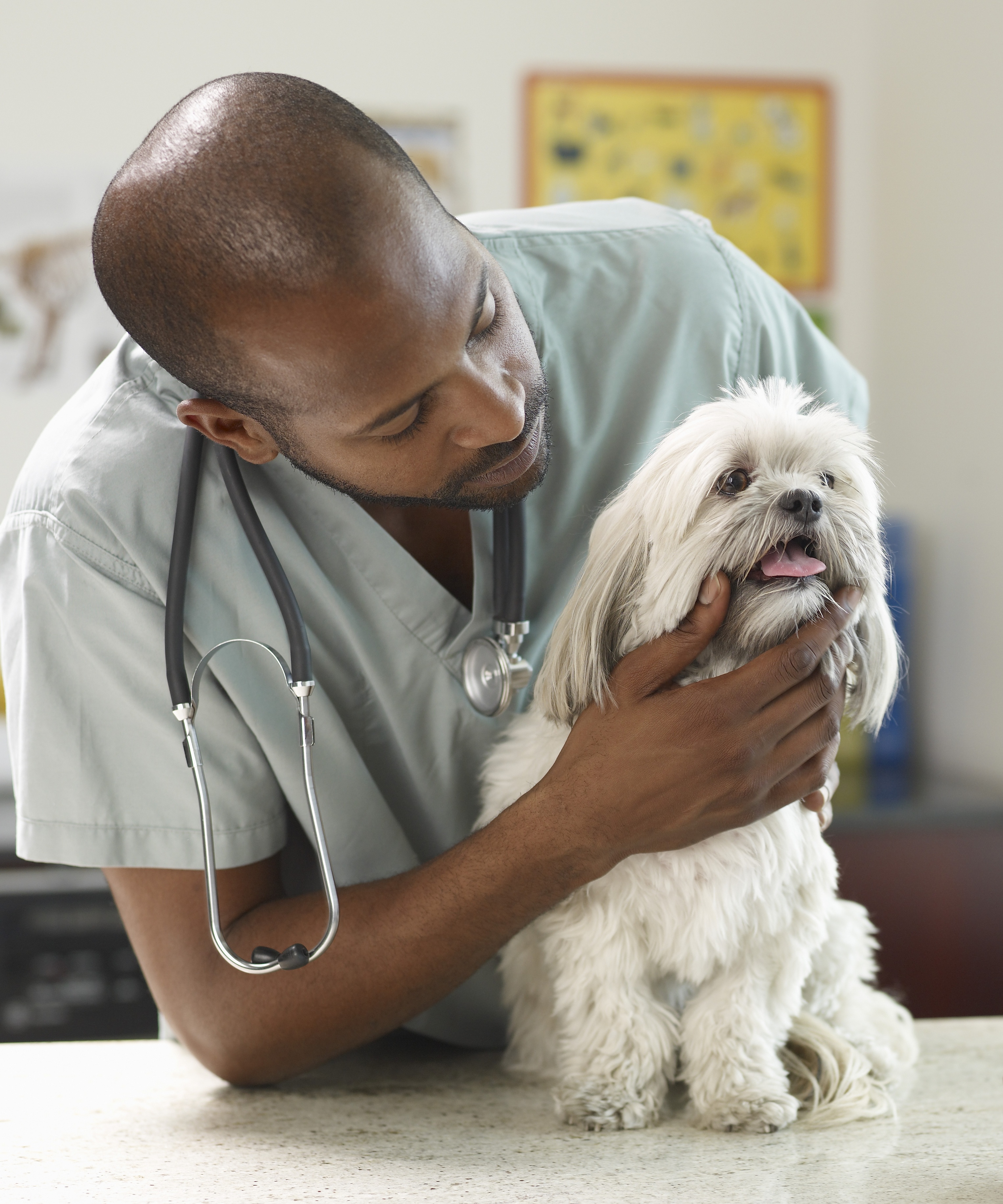
If you suspect your dog is sick, you can take its temperature with a rectal thermometer. A temperature above 102.5 °F (39.2 °C) is a fever and requires a veterinarian’s consultation. Sometimes dogs with a fever have a dry nose, but this is not a reliable way to judge whether a dog is sick.
Every new puppy should be taken to a veterinarian for a checkup and vaccinations. All pups should be vaccinated against common dog diseases, including canine distemper, canine hepatitis, leptospirosis, canine parvovirus, and canine parainfluenza. Veterinarians commonly vaccinate against all these infections with a combination shot known as the DHLPP (distemper hepatitis leptospirosis parvovirus parainfluenza). Puppies need a series of DHLPP injections beginning when they are 6 to 8 weeks of age and ending when they are just over 4 months old. Adult dogs should also be taken to the veterinarian yearly for a checkup. Booster shots, which maintain protection against these serious diseases, are given as needed every one to three years.
Another deadly disease that strikes dogs is rabies, which is usually transmitted by the bite of infected animals. A dog with rabies may bite and infect human beings. Puppies should receive a rabies vaccination at 3 to 4 months of age. The frequency of vaccination then depends on state law and the type of vaccine used. In most states, dogs need a rabies booster shot one year after the first vaccination, then every three years after that.
Parasitic worms cause health problems for many dogs. Many puppies are born with roundworms. To prevent spreading the parasites to other dogs and people, veterinarians recommend deworming pups with medication every two to three weeks until they are 3 to 4 months of age. A dog may acquire tapeworms by swallowing an infected flea or by eating raw fish or meat. Prevent tapeworm infection by good flea control and by letting your dog eat only wholesome, cooked foods.
A parasite called the heartworm may cause serious illness or even death. Adult heartworms live in the dog’s heart, but young forms of the worm are found in the blood. Mosquitoes transmit the infection after they feed on the blood of an infected dog and then bite another dog. All dogs in mosquito-infested areas should receive medicine to prevent heartworms. A dog’s annual checkup should include examinations for heartworms and other worms.
Social and moral responsibilities.
The privilege of owning a dog is accompanied by many responsibilities beyond providing proper care. Some of these responsibilities are enforced by the laws of certain communities. For example, many cities have laws that require dogs in public areas to be kept on a leash. Leash laws protect both the dog and the public. Unleashed dogs may dart into the street and be hit by cars. Dogs who run free may also bite people or fight with other dogs. In rural areas, free-roaming dogs may chase and injure wildlife and livestock. They may also eat poison, become caught in traps, or be shot by hunters or farmers.
Responsible dog owners clean up after their pet has a bowel movement. Some towns and cities fine owners who do not clean up after their dog.
Considerate owners make sure their dog does not disturb other people by barking or howling too much. Most dogs who are properly trained, well exercised, and given enough social contact do not make excessive noise.
Dog owners also have a moral and social responsibility to keep their pets from reproducing randomly. Each year, millions of healthy dogs are killed in animal shelters and pounds because homes for them cannot be found. This terrible overpopulation problem could be eliminated if more people prevented their dogs from having unwanted puppies.
Female dogs can become pregnant during estrus or heat, a period in which they are sexually receptive. This period usually occurs twice a year and lasts about two or three weeks. It is easy for an owner to prevent pregnancy in a female pet. The owner can keep the pet on a leash and can supervise her whenever the dog is outdoors until estrus has passed. A veterinarian can permanently prevent pregnancy by an operation that removes the female reproductive organs. This procedure is called an ovariohysterectomy or spaying. Most veterinarians recommend this surgery be done before the puppy’s first heat cycle at about 6 months of age. Many animal shelters and some veterinarians encourage or require the surgery at a younger age.
Male dogs can mate with numerous females, so it is irresponsible to allow them to roam unsupervised. An operation called castration makes a male dog permanently unable to father pups. This surgery may be performed on young puppies, but many veterinarians prefer to wait until the dog is 6 months old to allow fuller body development.
Training a dog
All dogs need training to live happily and successfully with human owners. Dogs learn most quickly if given rewards instead of punishment. It is also important to be consistent. Dogs who are sometimes corrected and other times allowed to misbehave may become confused and unruly.
Housetraining,
also called housebreaking, should begin as soon as you get your puppy. The process will normally take until the pup is at least 12 weeks of age. To housetrain your dog, confine it to a small area at night and whenever you leave it alone. You might use a small room, part of a room, a large box, or a shipping kennel or crate. The area should be just large enough to hold the pup’s bed, a newspaper-covered spot, and a water bowl. This method is called crate, den, or den-bed training. A pup confined in such an area will wait as long as possible to urinate or move its bowels because of a natural reluctance to soil its own bed.
Take your puppy out first thing in the morning, whenever it awakens from a nap, and after eating. Most dogs need to empty their bladder and bowels at these times. Give your puppy its last meal of the day early in the evening and take the dog out before bed. Whenever you take your pup out, stay with it until it urinates, has a bowel movement, or both. Then praise the dog for doing the right thing in the right place. This is the most important key to housetraining.
Correct your dog only when you catch it urinating or emptying its bowels in the wrong place. If possible, snatch the dog up in the middle of the act with a “No!” Take the pup outdoors to finish in an appropriate toilet area so you can give praise. It is useless to punish a housetraining error several hours after the act.
Obedience training
can also begin as soon as you get a new puppy. The first lesson your dog should learn is to let people handle it. Be sure to touch all parts of your pup’s body and look in its ears and mouth. Dogs who learn to tolerate or even enjoy such handling are easier to care for if they become sick. They are also less likely to bite people who try to touch them.
The first simple command to teach a dog is “No.” When your dog starts to do something it should not do, say “No” in a firm voice. In most cases, your command will startle the dog and it will stop whatever it was doing. When this happens, quickly say “Good dog” in a friendly, happy tone as a signal that your dog has done well. Always give correction or praise immediately.
Most dogs do not need physical punishment to learn the meaning of “No.” But if your dog does not respond to your voice alone, you can combine the “No” command with actions that imitate how the leader of a wolf pack disciplines pack members. For example, you might grasp your pup by the scruff of the neck and shake it gently or lift it slightly off the ground. Alternatively, use the neck hold to push a pup’s head toward the ground.
If your pet seems slow to realize what “Good dog” means, give the dog a treat, such as a bit of dog cookie, as you say the words. Dogs learn quickly when they are rewarded with food. Later, you can give the food reward less frequently until your dog responds to praise alone.
A good place for a puppy to learn to get along with other dogs is in a special socialization class. Dog trainers, veterinarians, and obedience clubs in many cities offer such instruction, often called puppy classes or puppy kindergarten. The owner learns how to train the pup, and the puppy is taught to sit, lie down, stand for examination, come, walk at heel, and stay. After graduating from puppy class, a dog is ready for more advanced obedience lessons.
Dog competitions.
Kennel clubs in many countries sponsor dog shows. At these competitive events, dogs are evaluated on their physical appearance. In the United States, the AKC regulates most dog shows, and dogs must be AKC-registered to compete. The club maintains official descriptions of each dog breed called breed standards. Breed standards include such details as the size and shape of the dog’s body and the color and texture of its coat. Other characteristics include temperament, type of movement, and how the coat must be trimmed. Show judges award points based on how closely an animal meets the breed standard.
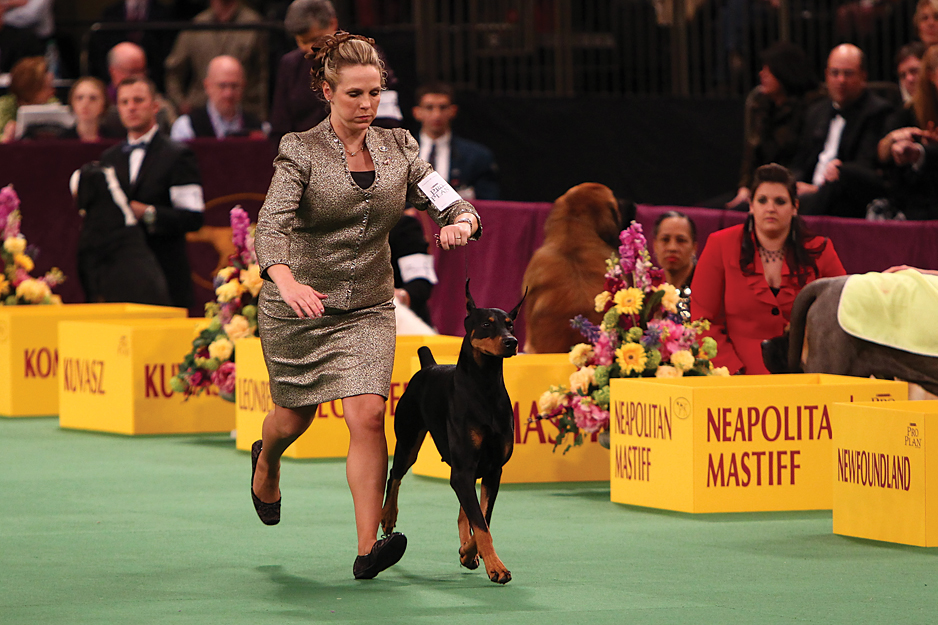
In an all-breed dog show, judges first select the best member of each recognized AKC breed. These dogs then compete against one another to be chosen best in each of the seven major groups of dogs. From these seven dogs, the judges name one as “best in show.”
At some dog shows, called bench shows, handlers must display their dogs in stalls mounted on benches when they are not competing in the show ring. The Westminster Kennel Club of New York City holds the most important bench shows in the United States in February at Madison Square Garden. The shows have been held annually since 1877.
Other competitive events for dogs include obedience trials, field trials, agility trials, and dog sports. Obedience trials test how people and dogs work together. Any recognized breed may compete, and appearance is not a factor in awarding points. Exercises at these trials may include jumping, retrieving, and scent discrimination.
Loading the player...Dog running agility course
Field trials are competitions for hunting breeds. Hounds are judged on their ability to pursue rabbits or hares by scent. Pointing breeds must stop and point when they scent a game bird planted in the trial field. Retrievers must fetch from both water and land. Spaniels must locate planted game, flush birds into the air, and retrieve on command.
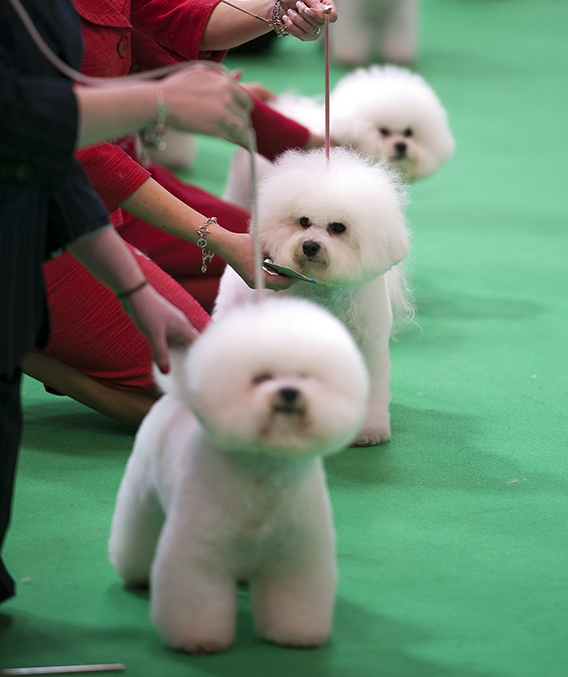
Agility trials and dog sports competitions are open to mixed-breed dogs as well as purebreds. They highlight a dog’s athletic ability and may include tests of climbing, tunnel running, and ball or frisbee catching.
History
Scientists believe that dogs developed from a weasellike, meat-eating animal called Miacis, which lived about 50 million years ago. Miacis was the ancestor not only of dogs but also of cats, bears, raccoons, civets, weasels, and skunks. A descendant of Miacis called Tomarctus appeared about 15 million years ago. Tomarctus resembled a wolf and is the direct ancestor of all members of the dog family, including wolves, coyotes, jackals, foxes, and domestic dogs.
Dogs are the oldest known domesticated animal. The earliest archaeological sites where human and domesticated dog remains occur together are from 11,000 to around 14,000 years old. Studies of DNA (deoxyribonucleic acid) from wolves and dogs suggest that domestication may have begun between 20,000 and 40,000 years ago.
The saluki, which is probably the oldest of present-day breeds, may have originated in the Middle East as early as 7000 B.C. Paintings and sculpture from ancient Egypt indicate that the Egyptians had developed various dog breeds by about 1500 B.C. These artworks depict heavy dogs resembling mastiffs and hunting dogs with long legs and pointed noses.
The English physician John Caius, who also used the name Johannes Caius, wrote one of the first books about dogs in 1570. Caius describes 16 breeds, including terriers, spaniels, setters, bloodhounds, greyhounds, shepherds, and mastiffs. The first kennel clubs formed in Europe in the 1800’s, and the first formal dog show took place in England in 1859 at Newcastle upon Tyne.
